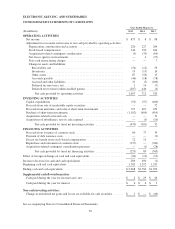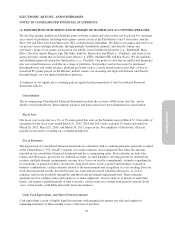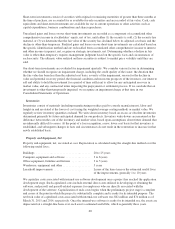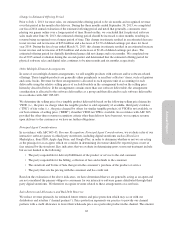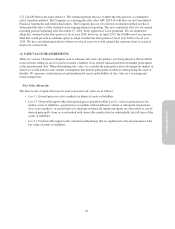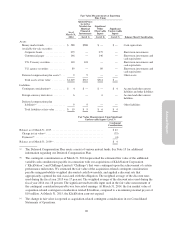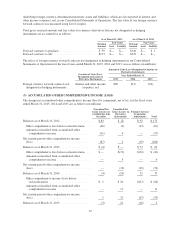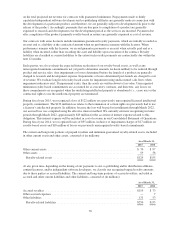Electronic Arts 2015 Annual Report Download - page 136
Download and view the complete annual report
Please find page 136 of the 2015 Electronic Arts annual report below. You can navigate through the pages in the report by either clicking on the pages listed below, or by using the keyword search tool below to find specific information within the annual report.Income Taxes
We recognize deferred tax assets and liabilities for both the expected impact of differences between the financial
statement amount and the tax basis of assets and liabilities and for the expected future tax benefit to be derived
from tax losses and tax credit carryforwards. We record a valuation allowance against deferred tax assets when it
is considered more likely than not that all or a portion of our deferred tax assets will not be realized. In making
this determination, we are required to give significant weight to evidence that can be objectively verified. It is
generally difficult to conclude that a valuation allowance is not needed when there is significant negative
evidence, such as cumulative losses in recent years. Forecasts of future taxable income are considered to be less
objective than past results, therefore, cumulative losses weigh heavily in the overall assessment.
In addition to considering forecasts of future taxable income, we are also required to evaluate and quantify other
possible sources of taxable income in order to assess the realization of our deferred tax assets, namely the
reversal of existing deferred tax liabilities, the carry back of losses and credits as allowed under current tax law,
and the implementation of tax planning strategies. Evaluating and quantifying these amounts involves significant
judgments. Each source of income must be evaluated based on all positive and negative evidence; this evaluation
involves assumptions about future activity. Certain taxable temporary differences that are not expected to reverse
during the carry forward periods permitted by tax law cannot be considered as a source of future taxable income
that may be available to realize the benefit of deferred tax assets.
In fiscal year 2015, we reported U.S. pre-tax income, compared to pre-tax losses in each of the last seven fiscal
years. We have not yet been able to establish a sustained level of profitability in the U.S. or other sufficient
significant positive evidence to conclude that our U.S. deferred tax assets are more likely than not to be realized.
Therefore, we continue to maintain a valuation allowance against most of our U.S. deferred tax assets. However,
it is reasonably possible that in fiscal year 2016 we will establish a sustained level of profitability in the U.S. As
a result, it is possible that a significant portion of the valuation allowance recorded against our U.S. deferred tax
assets at March 31, 2015 could be reversed by the end of fiscal year 2016.
Recently Adopted Accounting Standards
On April 1, 2014, we adopted ASU 2013-11, Presentation of an Unrecognized Tax Benefit When a Net
Operating Loss Carryforward, a Similar Tax Loss, or a Tax Credit Carryforward Exists. Under the new
accounting standard, an unrecognized tax benefit is required to be presented as a reduction to a deferred tax asset
if the disallowance of the uncertain tax position would reduce an available tax loss or tax credit carryforward
instead of resulting in a cash tax liability. The ASU applies prospectively to all unrecognized tax benefits that
exist as of the adoption date. As a result of the adoption, we reduced: (a) noncurrent income tax obligations by
$96 million; (b) current deferred income tax assets by $18 million; and (c) noncurrent deferred income tax assets
by $11 million. We increased noncurrent deferred income tax liabilities by $67 million. As the new accounting
standard only impacted presentation, it did not have an impact on the Company’s net financial position, results of
operations, or cash flows.
Impact of Recently Issued Accounting Standards
In April 2015, the FASB issued ASU 2015-03, Interest — Imputation of Interest (Topic 835-30), which requires
that debt issuance costs related to a recognized debt liability be presented in the balance sheet as a direct
deduction from the carrying amount of that debt liability, consistent with debt discounts. The recognition and
measurement guidance for debt issuance costs are not affected by this ASU. The disclosure requirements will be
effective for annual periods (and interim periods within those annual periods) beginning after December 15,
2015, and will require retrospective application. Early adoption is permitted. We do not expect the adoption to
have a material impact on our Consolidated Financial Statements.
In May 2014, the FASB issued ASU No. 2014-09, Revenue from Contracts with Customers (Topic 606), which
requires an entity to recognize the amount of revenue to which it expects to be entitled for the transfer of
promised goods or services to customers. The ASU will replace most existing revenue recognition guidance in
66




